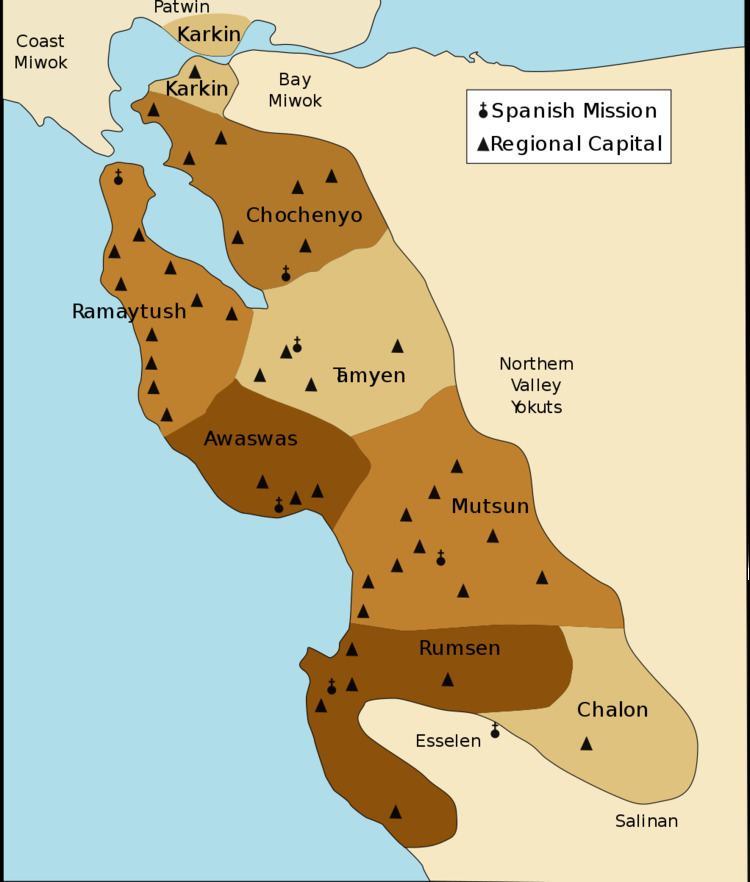Pronunciation /oʊˈloʊniː/ Ethnicity Ohlone people | Region California | |
 | ||
Language family Yok-UtianUtianOhlone ISO 639-3 Variously:cst – Northern Ohlonecss – Southern Ohlonekrb – Karkin | ||
The Ohlone languages, also known as Costanoan, are a small family of languages of the San Francisco Bay Area spoken by the Ohlone people. Along with the Miwok languages, they are members of the Utian language family. The most recent work suggests that Ohlone, Miwok, and Yokuts are branches of a Yok-Utian language family.
Contents
Languages
Costanoan comprises eight attested varieties: Awaswas, Chalon, Chochenyo (a.k.a. Chocheño), Karkin, Mutsun, Ramaytush, Rumsen, and Tamyen. Overall, divergence among these languages seems to have been roughly equivalent to that among the languages of the Romance sub-family of Indo-European languages. Neighboring groups seem to have been able to understand and speak to each other.
The number and geographic distribution of Ohlone language divisions partially mirrors the distribution of Franciscan missions in their original lands. While the known languages are, in most cases, quite distinct, intermediate dialects may have been lost as local groups gathered at the missions. A newly discovered text from Mission Santa Clara provides evidence that Chochenyo of the East Bay area and Tamyen of the Santa Clara Valley were closely related dialects of a single San Francisco Bay Costanoan language.
The Costanoan languages were all extinct by the 1950s. However, today Mutsun, Chochenyo and Rumsen are being "revitalized" (relearned from saved records).
The classification below is based primarily on Callaghan (2001). Other classifications list Northern Costanoan, Southern Costanoan, and Karkin as single languages, with the following subgroups of each considered as dialects:
Dialect or language debate
Regarding the eight Costanoan branches, sources differ on if they were eight language dialects, or eight separate languages. Richard Levy, himself a linguist, contradicted himself on this point: First he said "Costanoans themselves were a set of tribelets [small tribes] who spoke a common language... distinguished from one another by slight differences in dialect"; however after saying that, he concluded: "The eight branches of the Costanoan family were separate languages (not dialects) as different from one another as Spanish is from French" (Levy, 1978:485, "Language and Territory"). Randall Milliken (1995:24–26) stated in 1995 that there were eight dialects, citing missionary-linguist Felipe Arroyo de la Cuesta to the effect that the idioms seemed distinct as one traveled from mission to mission, but actually formed a dialect chain from one neighboring local tribe to another. Catherine Callaghan (1997, 2001), a linguist who steeped herself in the primary documents, offered evidence that the Costanoan languages were distinct, with only Ramaytush, Tamyen, and Chochenyo possibly being dialects of a single language. Milliken (2008:6), himself an ethnohistorian and not a linguist, shifted his position in 2008 to follow Callaghan, referring to separate Costanoan languages rather than dialects.
Native placenames
The Ohlone native people belonged to one or more tribes, bands or villages, and to one or more of the eight linguistic group regions (as assigned by ethnolinguists). Native names listed in the mission records were, in some cases, clearly principal village names, in others the name assigned to the region of a "multifamily landholding group" (per Milliken). Although many native names have been written in historical records, the exact spelling and pronunciations were not entirely standardized in modern English. Ethnohistorians have resorted to approximating their indigenous regional boundaries as well. (The word that Kroeber coined to designate California tribes, bands and villages, tribelet, has been published in many records but is advisably offensive and incorrect, per the Ohlone people.)
Many of the known tribal and village names were recorded in the California mission records of baptism, marriage, and death. Some names have come from Spanish and Mexican settlers, some from early Anglo-European travelers, and some from the memories of Native American "informants". Speakers were natives still alive who could remember their group's native language and details.
Some of the former tribe and village names were gleaned from the land maps ("diseños de terreno") submitted by grantees in applying for Spanish and Mexican land grants or designs ("diseños") that were drawn up in Alta California prior to the Mexican-American War. In this regard, large amounts of untranslated material is available for research in the records of Clinton H. Merriam housed at the Bancroft Library, and more material continues to be published by local historical societies and associations.
Spelling and pronunciation
Many of the original sounds were first heard and copied down by Spanish missionaries using Spanish as a reference language, subject to human error, later translated into English and Anglicized over time. Spelling errors crept in as different missionaries kept separate records over a long period of time, under various administrators. Ethnohistorians Kroeber, Merriam, and others interviewed Ohlone speakers and were able to define some pronunciations on word lists. Ethnolinguists have used this to some advantage to create phonetic tables giving some semblance of languages, notably the Selected Costanoan Words by Merriam.
Native words
A partial table of words comes from Indian Names for Plants and Animals Among California and other Western North American Tribes by Clinton Merriam. This published list covers 400 Ohlone-Costanoan words from interviews of native speakers. The Ohlone words listed are by "phonetic English" pronunciations.
